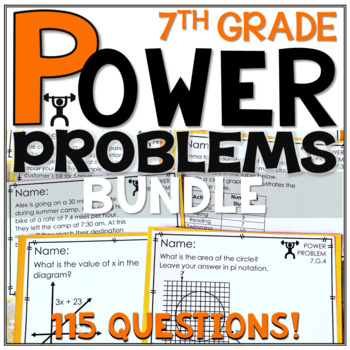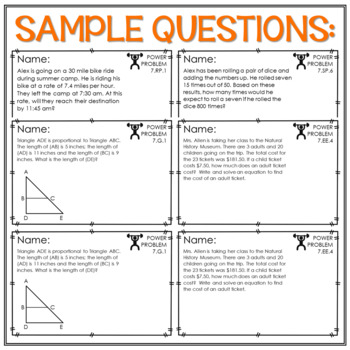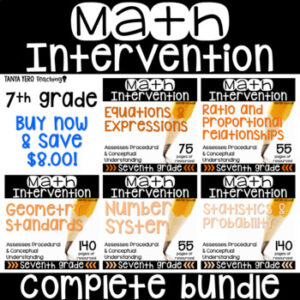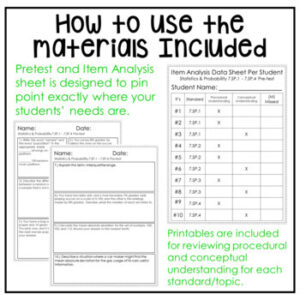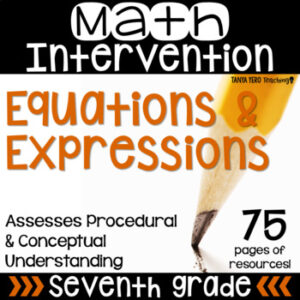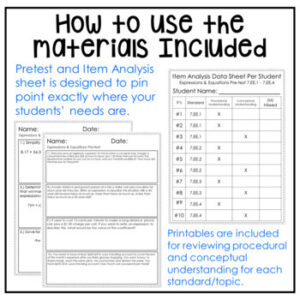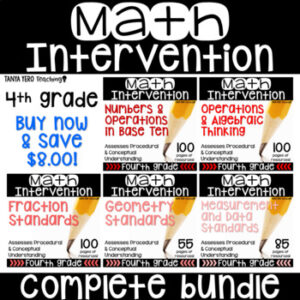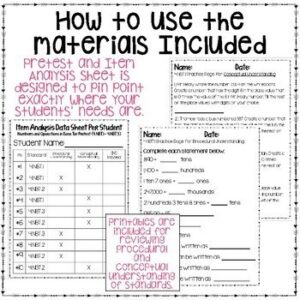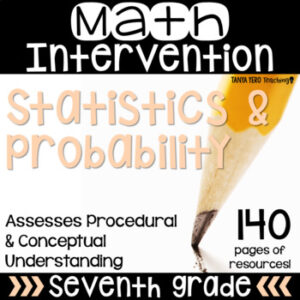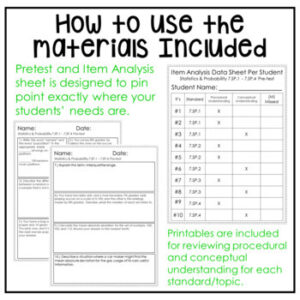Description
115 MATH COMMON CORE ALIGNED QUESTIONS TO TRANSFORM YOUR CLASSROOM! Perfect for morning work, math rotations, spiral review, and math practice!
5 questions per standard/topic!
Standards & Topics Covered
Ratio and Proportions
- 7.RP.1 – Compute ratios
- 7.RP.2 – Recognize and represent proportional relationships between quantities
- 7.RP.3 – Use scale factors and unit rates in proportional relationships to solve ratio and percent problems
The Number System
- 7.NS.1 – Addition and subtraction of rational numbers
- 7.NS.2 – Apply and extend previous understandings of multiplication and division
- 7.NS.3 – Solve real world problems with rational numbers
Expressions and Equations
- 7.EE.1 – Generating equivalent expressions with rational coefficients
- 7.EE.2 – Understand that equivalent expressions can reveal real-world and mathematical relationships
- 7.EE.3 – Solve multi-step real-world and mathematical problems posed with rational numbers in algebraic expressions
- 7.EE.4 – Use variables to represent quantities to solve real-world or mathematical problems
Geometry
- 7.G.1 – Solve problems involving scale drawings of geometric figures
- 7.G.2 – Understanding and classifying triangles
- 7.G.3 – Describe the two-dimensional figures
- 7.G.4 – Understand area and circumference of a circle.
- 7.G.5 – Angles
- 7.G.6 – Area, perimeter, and volume of various shapes
Statistics and Probability
- 7.SP.1 – Understanding statistics
- 7.SP.2 – Generate multiple random samples
- 7.SP.3 – Recognize the role of variability when comparing two populations
- 7.SP.4 – Use measures of center and measures of variability for numerical data from random samples to draw comparative inferences about two populations
- 7.SP.5 – Understand that the probability of a chance event is a number between 0 and 1 that expresses the likelihood of the event occurring
- 7.SP.6 – Experimental probability
- 7.SP.7 – Develop a probability model and use it to find probabilities of simple events
- 7.SP.8 – Determine probabilities of compound events using organized lists, tables, tree diagrams, and simulation
WHAT ARE P.O.W.E.R PROBLEMS?
PURPOSEFUL – These problems are meant to keep students focused, while strengthening initiative and perseverance.
OPPORTUNITIES – These prompts can be used in a variety of ways. P.O.W.E.R problems can be used to introduce a lesson, spiral review, or as formative assessments.
WITH
ENGAGEMENT – Problems are real world applicable and designed to hook students with interest and presentation. Complexity of problems promotes problem solving skills.
RIGOR – Tasks are specifically designed to challenge students and assess conceptual understanding of curriculum versus procedural understanding. Students will need to apply more than just a “formula.”
WHY USE P.O.W.E.R PROBLEMS?
BUILD STAMINA WITHIN YOUR STUDENTS!
P.O.W.E.R problems are designed to challenge your students with their open ended presentation. Majority of problems that come from textbooks and workbooks assess procedural understanding of curriculum. Some textbooks even provide step by step instructions where the textbook is thinking for the students and taking away that “productive struggle” for children. When we rob students of that event, we rob them of their ability to reason, problem solve, and see beyond a standard algorithm. P.O.W.E.R problems are meant to show students that there are different ways to answer one question in math. With these tasks students take ownership and are part of the problem solving process versus filling in blanks in a textbook.
HOW TO USE POWER PROBLEMS:
YOUR KIDS. YOUR CHOICE. FLEXIBILITY.
TO INTRODUCE A LESSON – P.O.W.E.R problems can be used to introduce a new skill. In this case your students will experience a “productive struggle.” Their problem solving skills and prior knowledge will kick in. Often times most of my students will have the incorrect answer or no answer at all. I then have someone explain their method/reasoning and allow my students to critique their peer’s answer. This makes for great accountable talk discussions. If I see that most students do not have an answer I will assist the class in getting to a specific point and then allow them to finish independently.
SPIRAL REVIEW – Avoid your students forgetting standards, by using P.O.W.E.R problems to spiral review previously taught lessons.
FORMATIVE ASSESSMENTS – You can use these problems to assess mastery and levels of understanding.


